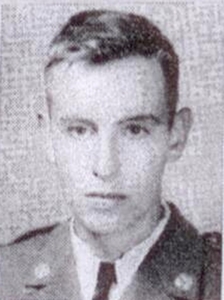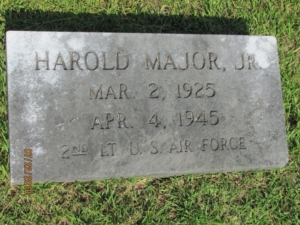Scroll of Honor – Harold Major, Jr.
B-24 Copilot
Written by: Kelly Durham
Harold Major, Jr. of Anderson enrolled as a freshman in the fall of 1942. Major was an engineering student and a member of the Anderson County Club. With the country at war, the future for his Class of 1946 was unsettled at best. Rumors flew across campus that fall and in early spring came official word that all cadets would be ordered to active duty upon the completion of the academic year.
Major volunteered for Army Air Force flight training. Pilot training consisted of four phases. In the primary phase, aviation cadets were taught basic flight skills while flying with an instructor pilot. This phase also included classroom instruction on the principles of flight. Basic training introduced cadets to formation flying, flight by instruments, aerial navigation, and cross country flying. In the advanced phase, cadets flew more complex and powerful aircraft. In this phase, pilots were designated for single engine or, in Major’s case, multi-engine assignments. The final phase was transition training during which pilots spent two months learning to fly the type of airplane they would fly in combat. In total, the pilot training regimen lasted about eleven months.
 Harold Major likely headed overseas as a B-24 bomber replacement pilot in late 1944. He was assigned to the 448th Bomb Group at Seething, England about ten miles southeast of Norwich and twenty miles west of the English Channel.
Harold Major likely headed overseas as a B-24 bomber replacement pilot in late 1944. He was assigned to the 448th Bomb Group at Seething, England about ten miles southeast of Norwich and twenty miles west of the English Channel.
On April 4, 1945, the 448th was alerted for a mission to bomb airfields in Germany. When the regular copilot on First Lieutenant James Shafter’s crew was unable to participate on the mission, Second Lieutenant Major volunteered to take his place. More than 1,400 heavy bombers escorted by 866 fighters departed airfields all over southeast England that morning. Major’s B-24 was part of a 97 plane formation bombing Wesendorf Airfield about 24 miles north of Brunswick, Germany. The B-24 was attacked by German fighters near the target and so heavily damaged that it could not remain in the air. Observers from nearby aircraft reported between five and ten parachutes exiting the stricken bomber. Lieutenant Major was believed to have bailed out of the aircraft, but reportedly, his parachute failed to open. Originally reported as missing in action, he was later confirmed to have been killed. Three weeks later, the 448th flew its last combat mission of the war.
Harold Major, Jr. was awarded the Purple Heart. He was survived by his parents and after the war his remains were returned to Anderson where he was buried in Old Silverbrook Cemetery.
For more information on Second Lieutenant Harold Major, Jr. see:
https://soh.alumni.clemson.edu/scroll/harold-major-jr/
For additional information about Clemson University’s Scroll of Honor visit:
https://soh.alumni.clemson.edu/
